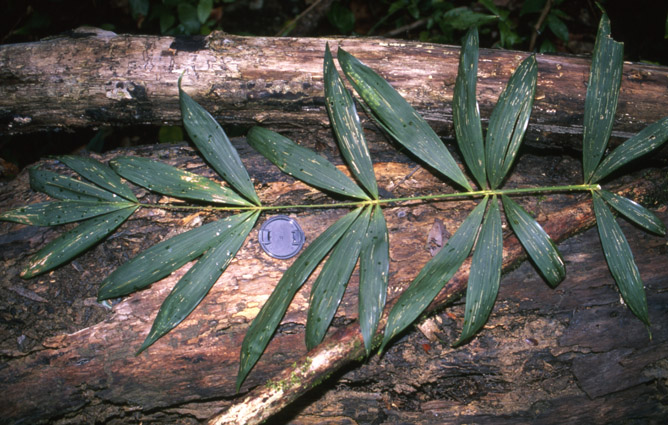- Acanthophoenix
- Acrocomia
- Actinokentia
- Actinorhytis
- Adonidia
- Aiphanes
- Allagoptera
- Ammandra
- Aphandra
- Archontophoenix
- Areca
- Arenga
- Asterogyne
- Astrocaryum
- Attalea
- Bactris
- Balaka
- Barcella
- Basselinia
- Beccariophoenix
- Bismarckia
- Borassodendron
- Borassus
- Brassiophoenix
- Burretiokentia
- Butia
- Calyptrocalyx
- Calyptrogyne
- Calyptronoma
- Carpentaria
- Carpoxylon
- Caryota
- Ceratolobus
- Ceroxylon
- Chamaedorea
- Chamaerops
- Chambeyronia
- Chelyocarpus
- Chuniophoenix
- Clinosperma
- Coccothrinax
- Cocos
- Corypha
- Cryosophila
- Cyphokentia
- Cyphophoenix
- Cyphosperma
- Daemonorops
- Deckenia
- Desmoncus
- Dictyocaryum
- Drymophloeus
- Dypsis
- Elaeis
- Eleiodoxa
- Eremospatha
- Eugeissona
- Euterpe
- Gaussia
- Geonoma
- Guihaia
- Hedyscepe
- Hemithrinax
- Howea
- Hyophorbe
- Hyospathe
- Hyphaene
- Iriartea
- Iriartella
- Itaya
- Jailoloa
- Johannesteijsmannia
- Juania
- Jubaea
- Jubaeopsis
- Kentiopsis
- Kerriodoxa
- Korthalsia
- Laccospadix
- Laccosperma
- Lanonia
- Latania
- Lemurophoenix
- Leopoldinia
- Lepidocaryum
- Lepidorrhachis
- Leucothrinax
- Licuala
- Linospadix
- Livistona
- Lodoicea
- Lytocaryum
- Manicaria
- Manjekia
- Marojejya
- Masoala
- Mauritia
- Mauritiella
- Maxburretia
- Medemia
- Metroxylon
- Myrialepis
- Nannorrhops
- Nenga
- Neonicholsonia
- Neoveitchia
- Nephrosperma
- Normanbya
- Nypa
- Oenocarpus
- Oncocalamus
- Oncosperma
- Orania
- Oraniopsis
- Parajubaea
- Pelagodoxa
- Phoenicophorium
- Phoenix
- Pholidocarpus
- Pholidostachys
- Physokentia
- Phytelephas
- Pigafetta
- Pinanga
- Plectocomia
- Plectocomiopsis
- Podococcus
- Pogonotium
- Ponapea
- Prestoea
- Pseudophoenix
- Ptychococcus
- Ptychosperma
- Raphia
- Ravenea
- Reinhardtia
- Retispatha
- Rhapidophyllum
- Rhapis
- Rhopalostylis
- Roscheria
- Roystonea
- Sabal
- Sabinaria
- Salacca
- Saribus
- Satakentia
- Satranala
- Schippia
- Sclerosperma
- Socratea
- Solfia
- Sommieria
- Syagrus
- Synechanthus
- Tahina
- Tectiphiala
- Thrinax
- Trachycarpus
- Trithrinax
- Veitchia
- Verschaffeltia
- Voanioala
- Wallaceodoxa
- Wallichia
- Welfia
- Wendlandiella
- Wettinia
- Wodyetia
- Zombia
- x Jubautia splendens
- ?? Acoelorrhaphe
- ?? Bentinckia
- ?? Brahea
- ?? Clinostigma
- ?? Colpothrinax
- ?? Copernicia
- ?? Cyrtostachys
- ?? Dictyosperma
- ?? Dransfieldia
- ?? Heterospathe
- ?? Hydriastele
- ?? Iguanura
- ?? Incertae sedis & excluded names
- ?? Loxococcus
- ?? Micronoma
- ?? Paripon
- ?? Pritchardia
- ?? Rhopaloblaste
- ?? Serenoa
- ?? Washingtonia

Distribution
Indochinese endemic. Thailand (North-east) and Laos (Central). (Evans, T., Sengdala, K., Thammavong, B., Viengkham, O.V. & Dransfield, J. 2002: A Synopsis of the Rattans (Arecaceae: Calamoideae) of Laos and Neighbouring Parts of Indochina)A
Discussion
- In life typical C. solitarius is easily identified by its high climbing, solitary habit and enormously long inflorescences and partial inflorescences. We could detect no differences from C. tetradactylus in rachilla or fruit structure, which suggests to us that these two species are very closely related. The identification of herbarium material presents some difficulties because habit is rarely recorded and plants of C. solitarius flowering for the first time (e.g. Khamphone 312) may produce rather depauperate inflorescences similar in dimensions to those of C. tetradactylus. This is best overcome by taking careful notes when collecting. The usually unbristled leaf margins of C. solitarius are a useful identification clue but not a diagnostic field character because occasional bristles are present in the available material and this feature is notably variable in other species in the region (for example, marginal bristles are absent from C. tetradactylus in central Laos). As discussed under C. dioicus, the inflorescence part of Poilane 5042 may well come from C. solitarius. Accepting this would represent such a major range extension that we prefer to await unambiguous material. (Evans, T., Sengdala, K., Thammavong, B., Viengkham, O.V. & Dransfield, J. 2002: A Synopsis of the Rattans (Arecaceae: Calamoideae) of Laos and Neighbouring Parts of Indochina)A
Biology And Ecology
- Evergreen forest at 200 - 600 m in Laos and at 200 m in Thailand. (Evans, T., Sengdala, K., Thammavong, B., Viengkham, O.V. & Dransfield, J. 2002: A Synopsis of the Rattans (Arecaceae: Calamoideae) of Laos and Neighbouring Parts of Indochina)A
Conservation
- Of high conservation concern. It is currently known from a limited range, within which it is the preferred small-diameter cane for harvesting. Regeneration is likely to be poor since the plant is single-stemmed. Although still abundant in some areas, declines are apparent and over-harvesting is a strong possibility. (Evans, T., Sengdala, K., Thammavong, B., Viengkham, O.V. & Dransfield, J. 2002: A Synopsis of the Rattans (Arecaceae: Calamoideae) of Laos and Neighbouring Parts of Indochina)A
Common Name
- wai thork, wai yong, wai hakyong, wai savang, wai noi (Laos), wai thork (Thailand). (Evans, T., Sengdala, K., Thammavong, B., Viengkham, O.V. & Dransfield, J. 2002: A Synopsis of the Rattans (Arecaceae: Calamoideae) of Laos and Neighbouring Parts of Indochina)A
Uses
- The cane is of high quality and is widely traded. Shoot edible but small. (Evans, T., Sengdala, K., Thammavong, B., Viengkham, O.V. & Dransfield, J. 2002: A Synopsis of the Rattans (Arecaceae: Calamoideae) of Laos and Neighbouring Parts of Indochina)A
Materials Examined
- See Evans et al. (2000), plus LAOS (CENTRAI,): Vientiane Province, Hin Heup Distr., 0.5 km W of Khon Phouk village, along Huay Saen stream, off Nam Lik R., 22 Aug. 1999, (stam.), Maxwell,J. F 99 - 151 (CMU, DONG). (Evans, T., Sengdala, K., Thammavong, B., Viengkham, O.V. & Dransfield, J. 2002: A Synopsis of the Rattans (Arecaceae: Calamoideae) of Laos and Neighbouring Parts of Indochina)A
- Log in to post comments

